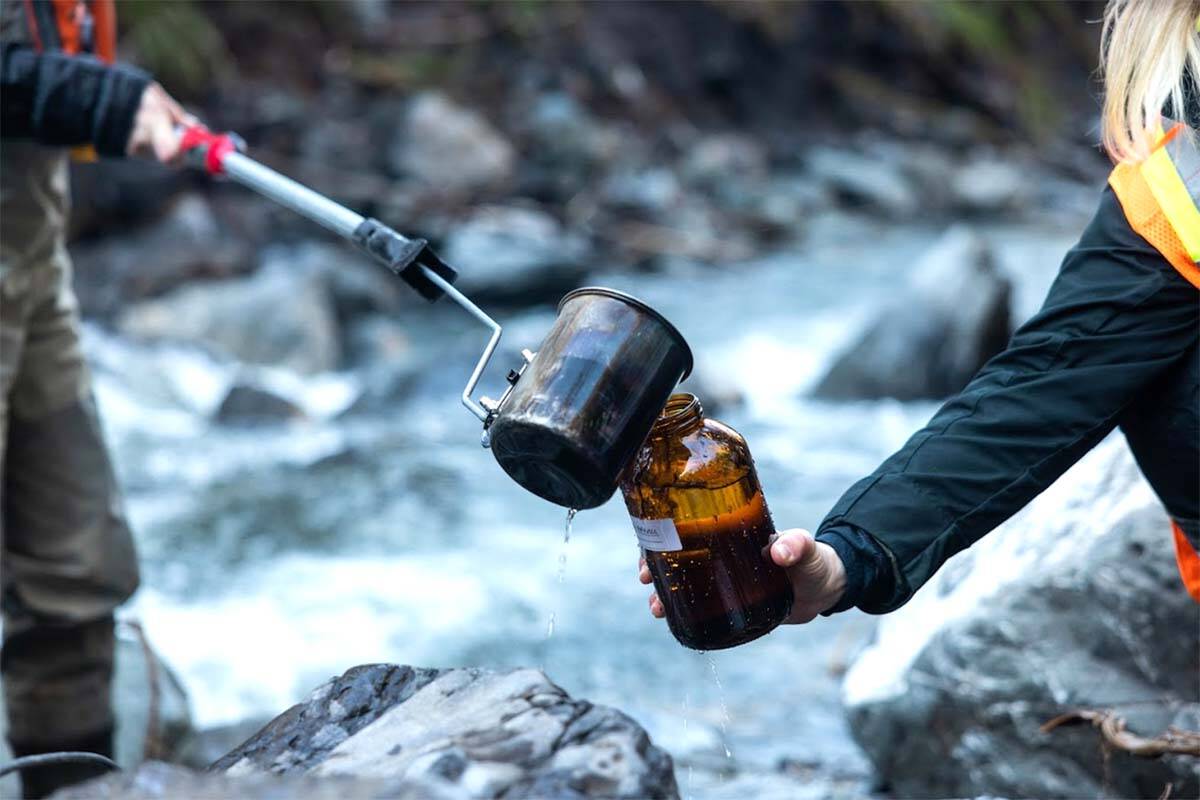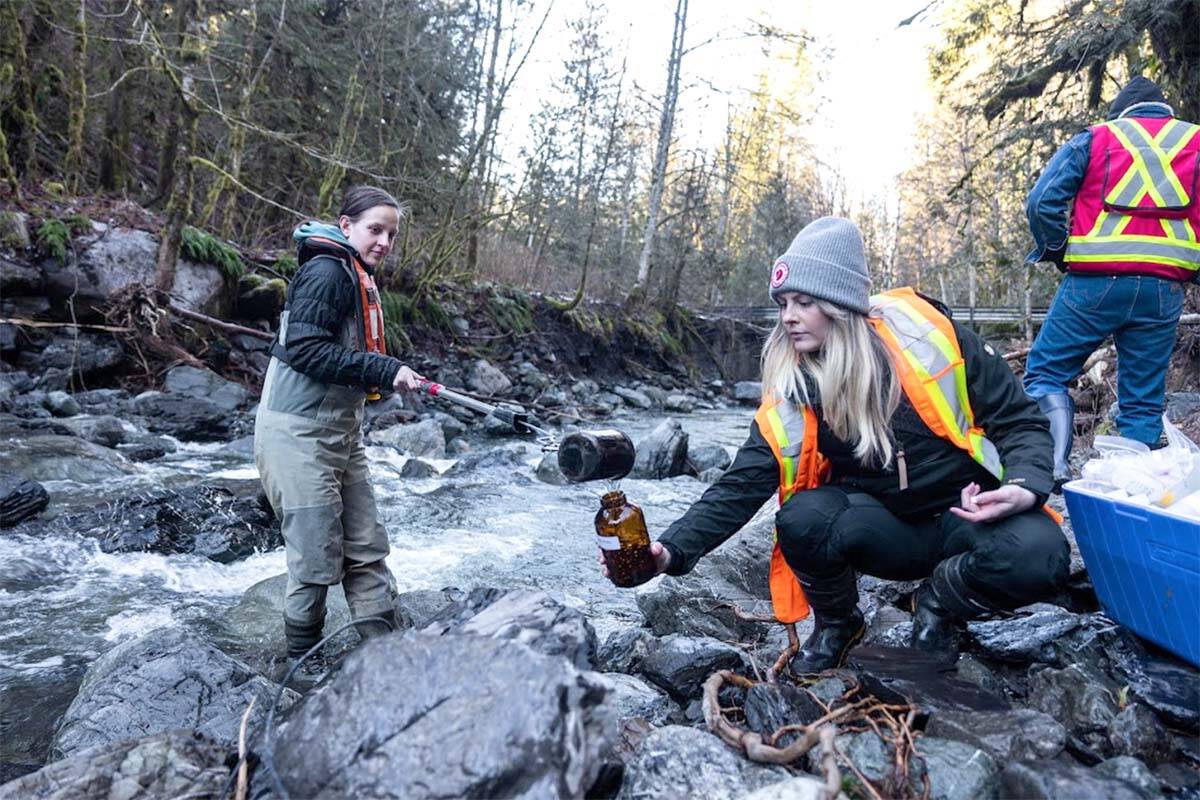An “astounding diversity” of contaminants, including cocaine and pesticides, was found in the Sumas Lake region following the November 2021 floods, according to a new report.
The findings raise “fundamental questions about the health of an area that is home to both fish and people,” states the Raincoast Conservation Foundation, which led the seven-week study of water samples taken from Dec. 15, 2021 to Feb. 2, 2022.
The report – titled A Lake Re-emerges: Analysis of Contaminants in the Sema:the Xo:tsa (Sumas Lake) Region Following the BC Floods of 2021 – was presented Thursday (Nov. 17) to Sumas First Nation in Abbotsford.
The former Sumas Lake is located on Sumas Prairie, which was submerged in floodwaters, starting on Nov. 15, 2021. The lake – covering 80 square kilometres – was drained by the Barrowtown Pump Station in 1924, but refilled during the disaster.
Raincoast states in a press release that the lack of data from before the disaster makes it difficult to determine the full impact of the floods on water quality, “but the degradation in the health of Sumas fish habitat became clear during this study.”
“Levels of fecal coliform were 641 times higher than the upstream reference site, pesticides were 135 times higher, pharmaceuticals were 60 times higher, nitrogen was 43 times higher, phosphorus was 19 times higher, and hydrocarbons were seven times higher,” Raincoast says.
RELATED: What’s in the floodwater? Toxicity of water detailed in recent Abbotsford study
The organization says 177 “new and emerging contaminants” were found, and there was “widespread detection” of cocaine, painkillers and pesticides.
The study identified excessive nutrients, metals, hydrocarbons, and pesticides as being the primary pollutants of concern, “underscoring the impacts of domestic and agricultural practices on the fish habitat that permeates the area.”
The report states that among the other contaminants found were fecal coliform, pharmaceuticals, personal-care products, perfluorinated compounds, sucralose and tire-related chemicals.
A total of 29 surface-water samples were collected from 11 sites – 10 from the former Sumas Lake and one upstream at Frosst Creek near Cultus Lake. A total of 379 analytes (chemical components and bacteria) were examined, including 262 anthropogenic contaminants (not found in nature).
VIDEO BY: RAINFOREST CONSERVATION FOUNDATION
Raincoast says an average of 87 analytes were detected at each sample location, of which 20 were anthropogenic chemicals not found in nature.
“There were 59 exceedances of Environmental Quality Guidelines among the surface water samples during the study, suggesting that fish habitat in the Semá:th X̱ó:tsa region is heavily degraded by multiple contaminants,” the organization states.
RELATED: ‘Stay out of any floodwater’: Experts offer safety advice for remediation work
Peter Ross, the report’s lead author and director of the Healthy Waters program at Raincoast, said the floods brought attention to a “notable deficiency” in environmental monitoring of Sumas Lake and in fish habitat in general.
“Our report reveals a collective failure to protect water and fish habitat from contamination arising from multiple activities in B.C. It is our hope that these findings contribute to innovation, stewardship and collective investment in green infrastructure that protects both communities and fish habitat,” he said.
Key findings from the study include that:
• water quality in the Sumas Lake area is poor, regardless of flooding, having been degraded by agricultural and domestic activities;
• fish are exposed to high levels of metals, pesticides and other contaminants of concern, and lower levels of life-giving dissolved oxygen;
• high nutrient levels, likely from agriculture and domestic sources, and slow moving waters from barriers and flood control structures, are likely contributing to low dissolved oxygen levels;
• the lack of riparian buffer zones along the edges of streams, rivers and canals in the Fraser Valley means that nutrients, pesticides and other contaminants wash easily into fish habitat during rainfall and flooding events;
• salmon are exposed to various human activities and pollutant discharges along their migratory journey for which the cumulative effects are not well understood;
• limited and inconsistent monitoring of water quality in B.C. constrains our ability to understand and manage risks associated with land-use practices and chemical uses;
• the consequences of climate change on water quality and water quantity in fish habitat in B.C. are uncertain, and we are poorly equipped to predict, understand and protect fish habitat into the future; and
• sustainable land use that protects and restores fish habitat will benefit from innovative and shared approaches to investments in resilient infrastructure and nature-based solutions.
The study was led by Raincoast and supported by the Lower Fraser Fisheries Alliance, the S’ólh Téméxw Stewardship Alliance, Sumas First Nation, Pacific Salmon Foundation, Fisheries and Oceans Canada, and the B.C. Ministry of Environment and Climate Change Strategy.
vhopes@abbynews.com
Like us on Facebook and follow us on Twitter




